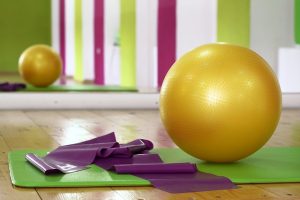It’s hard to keep up.
I don’t want to injure myself.
So much sweating is unpleasant.
I don’t have time.
I’m embarrassed to try. I’m such a klutz!
And _________.
Okay, fill in the blank. What’s YOUR biggest reason for avoiding exercise?
In my more than two decades of guiding people toward greater wellness, I’ve almost always found that a need for more regular exercise is part of a patient’s bigger wellness picture. Our bodies were not designed to stay still for long. We’re made to move—and the more we do that, the better we feel.
Yet listing reasons for not exercising is such a temptation. I know. I’ve heard them all. I admit, I may have even used a couple of them myself a time or two.
But rather than preach to you about the many merits of exercise—you’ve heard this before, right?—let’s take another approach today and bust a two-part fitness myth: that effective exercise requires lots of complicated equipment and expense.
Myth 1: A great workout demands a roomful of bulky, specialized equipment.

Not so! You can build a very well-rounded regimen using just a few lightweight tools:
- a foam roller: This simple tool will gently release tense, knotted muscles and ready them for exercise. Used as part of a warm-up, a roller will help to protect you from injuries that can arise from jumping in too abruptly or intensely. At the end of your workout, the same roller can also help calm and ease stressed areas.
- exercise bands: These long elastic bands are used to create resistance. The bands come in varying colors and strengths, so they can be employed in many ways—they’re like a whole set of cumbersome weights, except that they fit into a drawer or suitcase .
- a yoga mat: That little bit of cushioning is enough to make any ordinary floor a comfortable workout area.
- a stability ball: This tool is great for stretching during a warm-up or cool down, or for working a number of ab and leg exercises during your active workout. Note: Form is important for effectiveness and safety when you’re using a stability ball. Check out the many tutorials available on YouTube for tips that will keep you injury-free.
- sneakers: If you’re exercising on your feet, a supportive pair of shoes designed for the job is a must.
- your own body weight: That’s right; this is “equipment” you already own! The resistance offered by your own mass is what makes exercises like push-ups challenging, but also perfectly portable.
Myth 2: Personal trainers, gym memberships, and custom equipment make exercise too expensive.
![]()
Spending a ton to get a workout is a choice, not a necessity. You can easily assemble your own “gym” consisting of everything I listed above for under $150. Add any number of free instructional videos from YouTube or similar sites, and you have everything you need.
You absolutely can enjoy regular exercise right in the comfort and privacy of your own home. Not a lot of space? Not an issue. You can adapt. For example, rather than work a complicated aerobics routine, you can march in place, with intervals of jumping jacks added for cardio.
But look a little more widely than your living room, too. Chances are, all it takes is a good pair of sneakers to add exercise easily to your daily routine—no joining fees needed!
- Do you live only a mile or two from your workplace, grocery store, or favorite social gathering spot? Skip the commute and walk there instead.
- Do you have a sidewalk or inviting green space near your home? Go for a jog and get to know your neighborhood.
- Do you have stairs at home or at work? Who needs an elevator when your own legs can do the job!
A note about walking for fitness: While nothing is wrong with a casual stroll, you’ll obtain the best overall health benefits if you walk at a pace that raises your heart rate. Or, try an interval training approach: Alternate that moderate walk with shorter bursts of speed-walking or jogging.
Let’s talk about those stairs, too, especially if you happen to be a “woman of a certain age.” A recent study suggested that stair climbing may be an ideal exercise for postmenopausal women. After adopting a four-day-per-week stair climbing routine, study participants enjoyed decreased body fat, greater strength in their lower bodies, and a reduced risk of osteoporosis. And all of this came without the spike in blood pressure that the same demographic sometimes experiences with other forms of exercise. That’s a lot of benefit wrapped up in one simple fitness plan.
So maybe we’re not all sold on the gym scene. But with a little creativity, you’ll find that regular exercise is completely doable, regardless of what excuses have been holding you back. Please don’t deny your body the movement and purposeful challenge it needs to stay vital. Flexibility, heart health, mental clarity, freedom from stiffness and soreness, and more are yours for the taking. Now lace up those sneakers and claim them!
